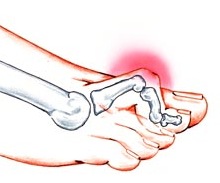The toes may seem small and relatively insignificant, but they are vital to walking and working. There are at least six sets of muscles that control each toe. Two tendons join on the dorsal aspect (top) of the toes and insert into the middle and distal phalanges of each toe. On the bottom (plantar aspect) of the toes are two more muscles that, instead of joining like the extensors, remain separate. Each muscle stabilizes one of the bones in the toe. The flexor digitorum longus muscle attaches to the bone at the end of the toe (distal phalanx) and the flexor digitorum brevis attaches to the middle phalanx. The lumbrical and the interossei muscles stabilize the proximal phalanx (inner toe bone).
If there is an imbalance in the foot, these smaller muscles can be overpowered by the larger flexor and extensor muscles. If the flexor digitorum longus contracts first and overpowers the smaller muscles, it can pull on the proximal phalanx, causing the outer two joints of the toe to bend downward. This results in a hammertoe. Hammertoe may seem minor, but if left untreated, it can become serious fixed deformities. In this unnatural position, the inside of the footwear rubs against the bent toe joints, gradually causing calluses to form, usually on the tops of the toes. The metatarsal heads support the body weight and pressure calluses and ulcers can develop on the sole of the foot.
When deformities reach this stage, the toes are fixed in a bent position and cannot be easily straightened. For this reason, it is important to see a podiatrist for hammertoe when it first begins to develop. Treatment for hammertoe depends on the severity of the deformity. When the toes first start to buckle, they can be straightened easily. If flat feet cause the problem, a podiatrist can fit the patient for custom-molded orthotics that provide a better arch for the foot and help the muscles work together. In these cases, the prognosis is good. Without treatment, the soft tissue structures that attach to hammertoe begin to tighten. Adhesions gradually form from the tendons to the joint capsules and a rigid deformity results. In these cases, surgery is necessary. Such surgery can keep you off your feet for several weeks. It’s vital to tend to conditions like these so that you can continue to work.




